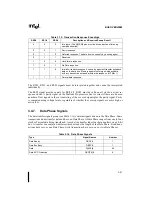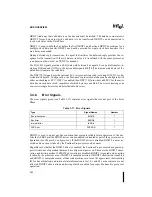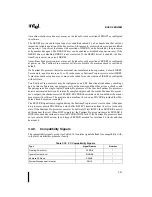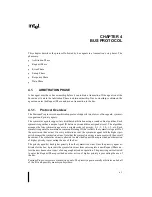
3-12
BUS OVERVIEW
3.4.2.
Arbitration Phase Signals
This signal group is used to arbitrate for the bus.
Up to five agents can simultaneously arbitrate for the bus, one to four symmetric agents (on
BREQ[3:0]#) and one priority agent (on BPRI#). Pentium Pro processors arbitrate as symmetric
agents. The priority agent normally arbitrates on behalf of the I/O subsystem (I/O agents) and
memory subsystem (memory agents).
Owning the bus is a necessary condition for initiating a bus transaction.
The symmetric agents arbitrate for the bus based on a round-robin rotating priority scheme. The
arbitration is fair and symmetric. After reset, agent 0 has the highest priority followed by agents
1, 2, and 3. All bus agents track the current bus owner. A symmetric agent requests the bus by
asserting its BREQn# signal. Based on the values sampled on BREQ[3:0]#, and the last sym-
metric bus owner, all agents simultaneously determine the next symmetric bus owner.
The priority agent asks for the bus by asserting BPRI#. The assertion of BPRI# temporarily
overrides, but does not otherwise alter the symmetric arbitration scheme. When BPRI# is sam-
pled active, no symmetric agent issues another unlocked bus transaction until BPRI# is sampled
inactive. The priority agent is always the next bus owner.
BNR# can be asserted by any bus agent to block further transactions from being issued to the
bus. It is typically asserted when system resources (such as address and/or data buffers) are
about to become temporarily busy or filled and cannot accommodate another transaction. After
bus initialization, BNR# can be asserted to delay the first bus transaction until all bus agents are
initialized.
The assertion of the LOCK# signal indicates that the bus agent is executing an atomic sequence
of bus transactions that must not be interrupted. A locked operation cannot be interrupted by an-
other transaction regardless of the assertion of BREQ[3:0]# or BPRI#. LOCK# can be used to
implement memory-based semaphores. LOCK# is asserted from the first transaction’s Request
Phase through the last transaction’s Response Phase.
Table 3-3. Arbitration Phase Signals
Pin/Signal Name
Pin Mnemonic
Signal Mnemonic
Number
Symmetric Agent Bus Request
BR[3:0]#
BREQ[3:0]#
4
Priority Agent Bus Request
BPRI#
BPRI#
1
Block Next Request
BNR#
BNR#
1
Lock
LOCK#
LOCK#
1
Summary of Contents for Pentium Pro Family
Page 17: ...1 Component Introduction ...
Page 26: ...2 Pentium Pro Processor Architecture Overview ...
Page 27: ......
Page 36: ...3 Bus Overview ...
Page 62: ...4 Bus Protocol ...
Page 105: ...5 Bus Transactions and Operations ...
Page 126: ...6 Range Registers ...
Page 131: ...7 Cache Protocol ...
Page 135: ...8 Data Integrity ...
Page 148: ...9 Configuration ...
Page 161: ...10 Pentium Pro Processor Test Access Port TAP ...
Page 172: ...11 Electrical Specifications ...
Page 201: ...12 GTL Interface Specification ...
Page 229: ...13 3 3V Tolerant Signal Quality Specifications ...
Page 233: ...14 Thermal Specifications ...
Page 239: ...15 Mechanical Specifications ...
Page 241: ...15 2 MECHANICAL SPECIFICATIONS s Figure 15 1 Package Dimensions Bottom View ...
Page 252: ...16 Tools ...
Page 260: ...16 8 TOOLS Figure 16 4 Generic MP System Layout for Debug Port Connection ...
Page 264: ...17 OverDrive Processor Socket Specification ...
Page 290: ...A Signals Reference ...
Page 320: ...Index ...
Page 328: ......
















































